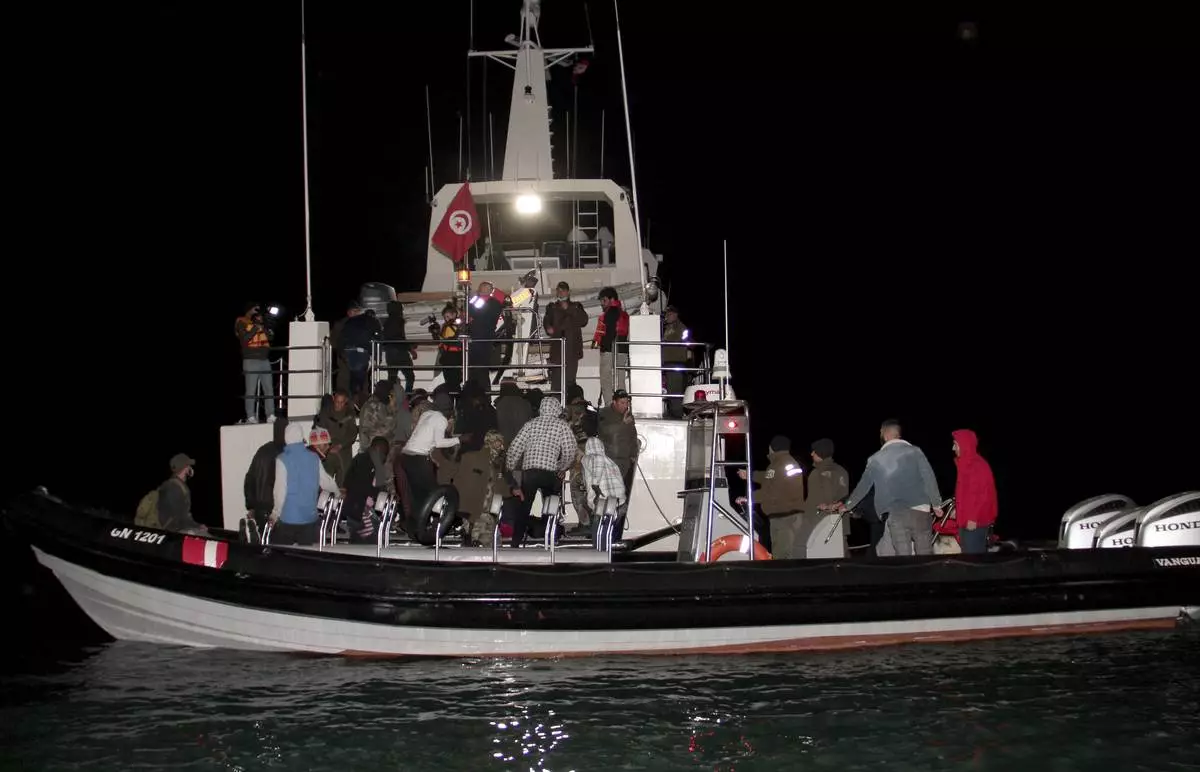Federal scientists are trying to decide if it's time to let the big dogs out.

In this 2013 photo provided by the U.S. Department of Agriculture, a Kangal dog greets Ben Hofer of the Hutterite Rockport Colony near Pendroy, Mont. (Julie Young/U.S. Department of Agriculture via AP)
Nearly 120 dogs from three large breeds perfected over centuries in Europe and Asia to be gentle around sheep and children but vicious when confronting wolves recently underwent a study to see how they'd react to their old nemesis on a new continent.
The dogs were gathered as puppies in Portugal, Bulgaria, and Turkey and sent to the American West, where they spent four years guarding sheep.
"When we were first looking at doing this, a lot of people wanted to know: What dog do I use in dealing with wolves and grizzly bears?" said Julie Young, a Utah-based research biologist with the U.S. Agriculture Department's National Wildlife Research Center.
The department looked to areas where dog breeds developed to guard sheep against wolves and brown bears. Then scientists supplied Cao de Gado Transmontanos, a large though lean and agile dog developed in a mountainous region of Portugal; Karakachans, developed by nomadic sheepherders in a mountainous area of Bulgaria; and Kangals, another powerful breed with an instinct for guarding, this one originating in Turkey.
Dogs from all three breeds can weigh up to 140 pounds (64 kilograms), about the size of a wolf. The dogs were sent to guard 65 herds in Idaho, Montana, Wyoming, Washington, and Oregon.
Scientists are still analyzing information from notes, remote cameras and GPS collars, Young said, with four or five scientific papers expected in the next year. But overall, she said, the dogs did well keeping away wolves and better than traditional guard dogs at deterring coyotes.
One dog died during the study. It was hit by a vehicle as sheep crossed a road.
For decades, most U.S. sheep producers have used large white dogs such as Great Pyrenees, Akbash or Maremma Sheepdogs. Light brown Anatolian Shepherds are also used.
But the reintroduction of wolves in the American West in the 1990s has led to questions about whether those breeds are up to the task. Since wolves returned to Idaho in 1995, the Agriculture Department's Wildlife Services says, wolves have killed 50 guard dogs through the end of last year and injured nearly 40 others in the state. Federal officials in 2017 killed 56 wolves in Idaho due to attacks on livestock.
Young said the study found wolves left areas when sheep bands, dogs and herders arrived, but their absence emboldened smaller predators such as coyotes.
Not all dogs in the study succeeded. Jill Swannack, president of the Washington State Sheep Producers, is a veterinarian who also has a ranch with about 800 sheep on private land in eastern Washington state. She received three Karakachans.
"When we came home, they preferred to be home with us," she said. "They really didn't bond to the sheep."
She also said the dogs were only about 70 or 80 pounds (32 to 36 kilograms). One went to a young family with sheep near their house, and now that dog plays with the children and has successfully guarded those sheep against coyotes.
The dogs that work best at her ranch are Anatolian Shepherds, though wolves killed one in 2014.
Wolves are a "phenomenal predator," Swannack said. "I would be happy if we didn't have them, but I'm also a realist, and we do have them. So we need the tools to deal with them and the support."
Ranchers can call the Agriculture Department's Wildlife Services to kill wolves that attack livestock. Environmentalists, though, have been working to reduce the need for that and see guard dogs as one solution.
"Most of the year, the livestock guardian dogs are an excellent deterrent," said Suzanne Stone of Defenders of Wildlife, noting the exception is in the spring when wolves are guarding dens with pups.
The imported guard dogs cost about $500 apiece, including transportation to the U.S., Young said, and nearly all were just a few months old when they arrived.
She said the Karakachans tended to be more vigilant, the Kangals inclined to investigate, and the Cao de Gado Transmontanos better at assessing threats. Ultimately, she said, sheep producers might benefit from a mix of dogs that includes some that stick near the sheep and others that patrol the perimeter.
Another part of the study involved the relationship between dogs and herders, many Peruvians, which will be one of the scientific papers.
"There's a bond there," Young said. "Just from watching them and looking at data, the ones who were better bonded, the dogs just seemed to perform better."
RABAT, Morocco (AP) — Children dead in the English Channel. Morgues full of migrants reaching capacity in Tunisia. Police in Cyprus patrolling off the island nation’s eastern coast to thwart boats loaded with Syrian refugees.
With pivotal June elections for the European Parliament getting closer, such scenes of despair and tragedy are complicating efforts to open a new chapter in Europe’s migration policy. As the European Union and countries across the 27-member bloc adopt tougher measures on migrants, politicians largely focus their rhetoric on the need to police human trafficking and smuggling — rather than the human drama playing out at sea.
Human rights organizations have for years warned that tougher policies and police crackdowns are not deterring migration but driving desperate people to attempt life-threatening journeys across treacherous waters. Thousands have paid with their lives.
On Tuesday, Tunisia's Coast Guard recovered 19 bodies near a section of the country's coastline known as a primary point of departure for boats taking off for Italy. Separately, five smugglers were arrested on human trafficking charges, authorities said. Tunisia has already intercepted about 21,000 migrants trying to cross the sea to Europe this year.
Human trafficking charges in Tunisia carry a prison sentence of up to 20 years.
In France, five people, including a 7-year-old child, died Tuesday while trying to cross the English Channel and reach the United Kingdom — just hours after the British government approved a law allowing the deportation of some migrants who entered the country illegally to Rwanda.
The disaster unfolded as French authorities spotted several boats packed with migrants off the coast of Pas-de-Calais early on Tuesday morning. Some 25 minutes after taking off, an inflatable dinghy with 112 people ran into a sandbank and French Navy ships were deployed to help.
They rescued 49 people from the doomed vessel and brought them ashore, along with the bodies of the five who perished. However, 58 refused to disembark.
The migrants still onboard managed to restart the engine and took off again, along with several other boats that sailed off the northern coast early Tuesday, followed by the French maritime gendarmerie patrol boat, according to a statement from the prefecture responsible for the north of France.
“The particularly large number of people crammed onto this boat highlights the dangerous methods of smugglers, who pack people on these vessels, overcrowding them, in complete disregard for lives, in order to make a profit,” it said.
The boats presumably reached the U.K., where three men were arrested in connection with deaths of the five on the French side of the Channel, the U.K.'s National Crime Agency Agency said Wednesday. Two Sudanese men and a citizen of South Sudan were detained in a nighttime raid by immigration enforcements officers on suspicion of facilitating illegal immigration and entering the U.K. illegally, the statement said.
Prime Minister Rishi Sunak has vowed to crack down on human smugglers.
“For matters of compassion more than anything else, we must actually break this business model and end the unfairness of people coming to our country illegally,” Sunak said Tuesday.
The perilous sea journeys taken by people have long been a political flashpoint in Europe. Many are fleeing conflict, poverty or persecution in Africa, Middle East and Asia, hoping for a better life on European shores.
Lawmakers have increasingly enacted policies designed to deter, detain and deport migrants, pushed by far-right politicians whose claims that migration is as a threat to national security has gained more and more traction.
Governments have revamped their own migration policies and reached new agreements with neighboring countries to prevent crossing attempts. European Union lawmakers passed a set of new migration laws earlier this month to share responsibility for those resettling on the continent and expedite deportations of those deemed ineligible to stay.
The 27-country bloc has pledged billions of dollars over the past year to countries including Tunisia, Mauritania and Egypt to provide general government aid, migrant services and border patrols.
In accords that European leaders hailed as a “template” for other countries, Tunisia and the EU reached a $1.1 billion agreement last July that includes funding for migration assistance and border patrol. The majority of funds have yet to be disbursed and are contingent on the country reaching an agreement with the International Monetary Fund on a stalled bailout package.
However, the effectiveness of deterrence as a policy is being debated. The number of migrants and refugees reaching Europe without authorization has risen since 2020, when less than 96,000 arrived by sea. That number rose steadily through last year, when more 270,000 arrived by sea, according to the United Nations refugee agency.
An estimated 30,000 people made the crossing last year, according to figures from the U.K. government. As of Sunday, more than 49,000 migrants have reached Europe by sea this year, authorities say.
Though the primary routes shift, arrivals by sea are similar to last year. In the first four months of 2023, nearly 54,000 reached Europe, according to government data gathered by the UNHCR. That figure does not include the thousands who entered Europe by land through countries along the continent's eastern and south-eastern borders, including Ukraine.
Surk reported from Nice, France. Associated Press writers Bouazza Ben Bouazza in Tunis, Tunisia, and Danica Kirka in London contributed to this report.
Follow AP’s global migration coverage at: https://apnews.com/hub/migration

FILE - Migrants, mainly from sub-Saharan Africa, are stopped by Tunisian Maritime National Guard at sea during an attempt to get to Italy, near the coast of Sfax, Tunisia, Tuesday, April 18, 2023. The bodies of 19 people were recovered Tuesday, April 23, 2024, off the coast of Tunisia, one of the primary points of departure for those seeking to traverse the Mediterranean Sea to Europe. More than 49,000 people have come to Europe by sea this year, including more than 7,000 from Tunisia to Italy. (AP Photo, File)

FILE - Migrants, mainly from sub-Saharan Africa, are stopped by Tunisian Maritime National Guard at sea during an attempt to get to Italy, near the coast of Sfax, Tunisia, Tuesday, April 18, 2023. The bodies of 19 people were recovered Tuesday, April 23, 2024, off the coast of Tunisia, one of the primary points of departure for those seeking to traverse the Mediterranean Sea to Europe. More than 49,000 people have come to Europe by sea this year, including more than 7,000 from Tunisia to Italy. (AP Photo, File)












